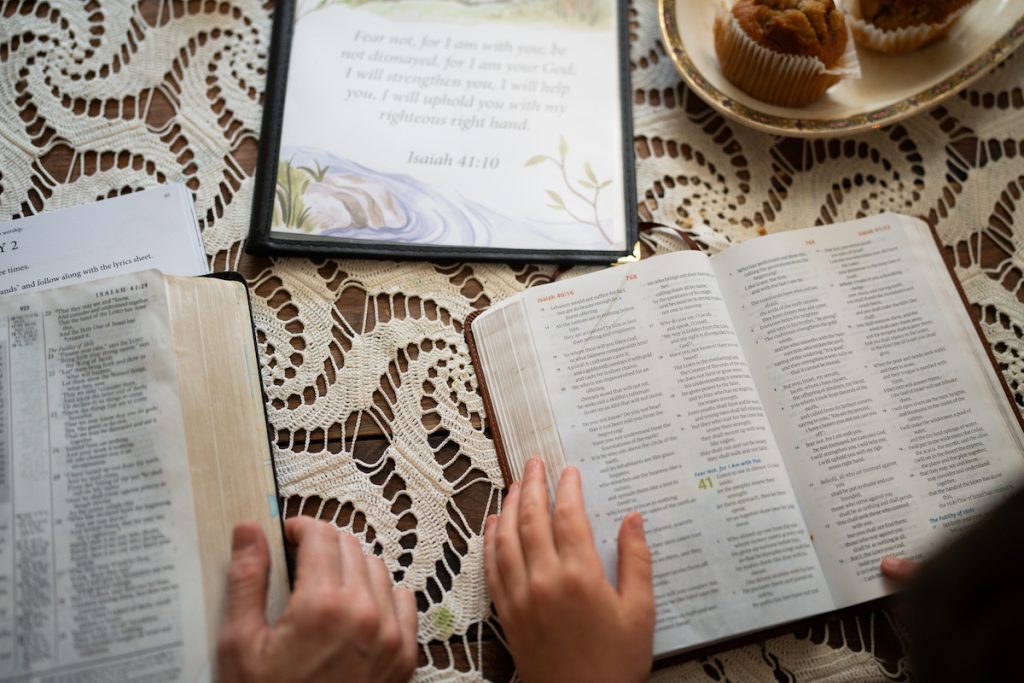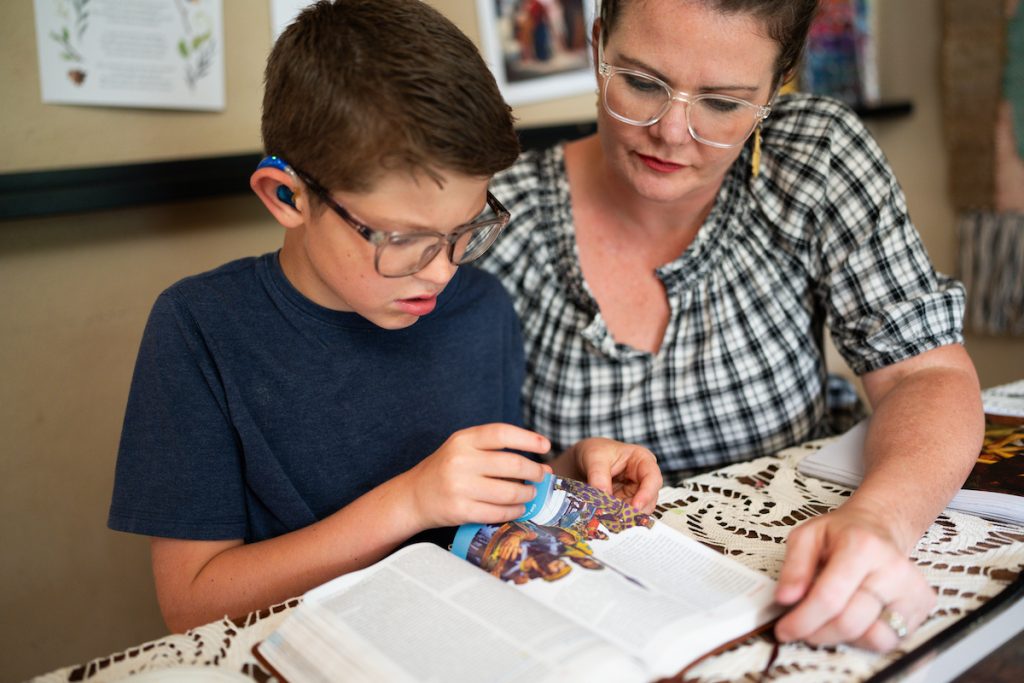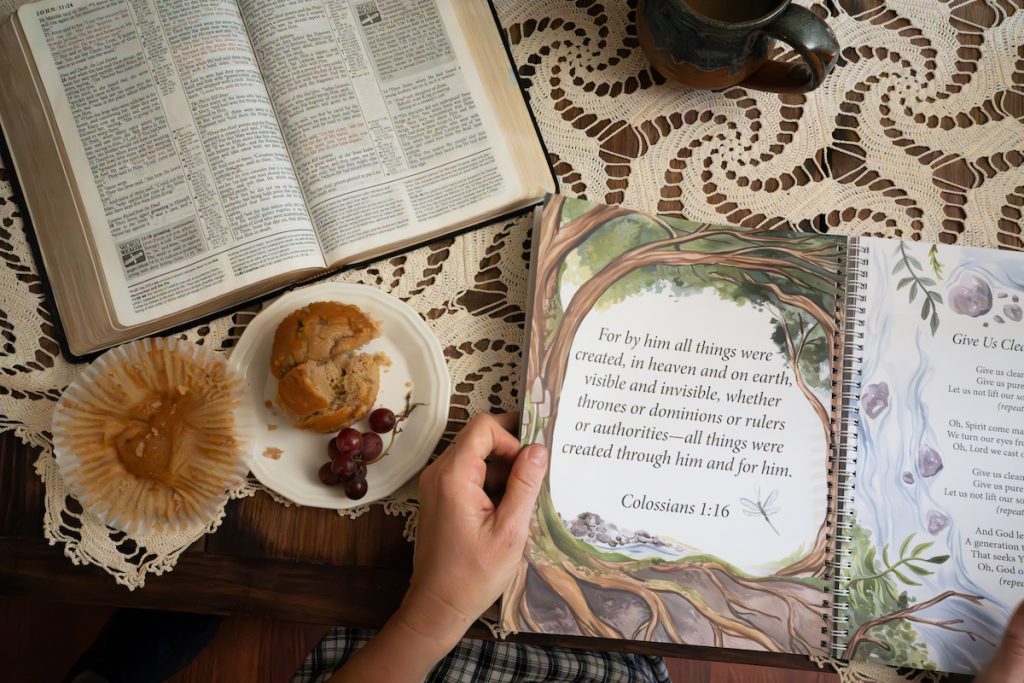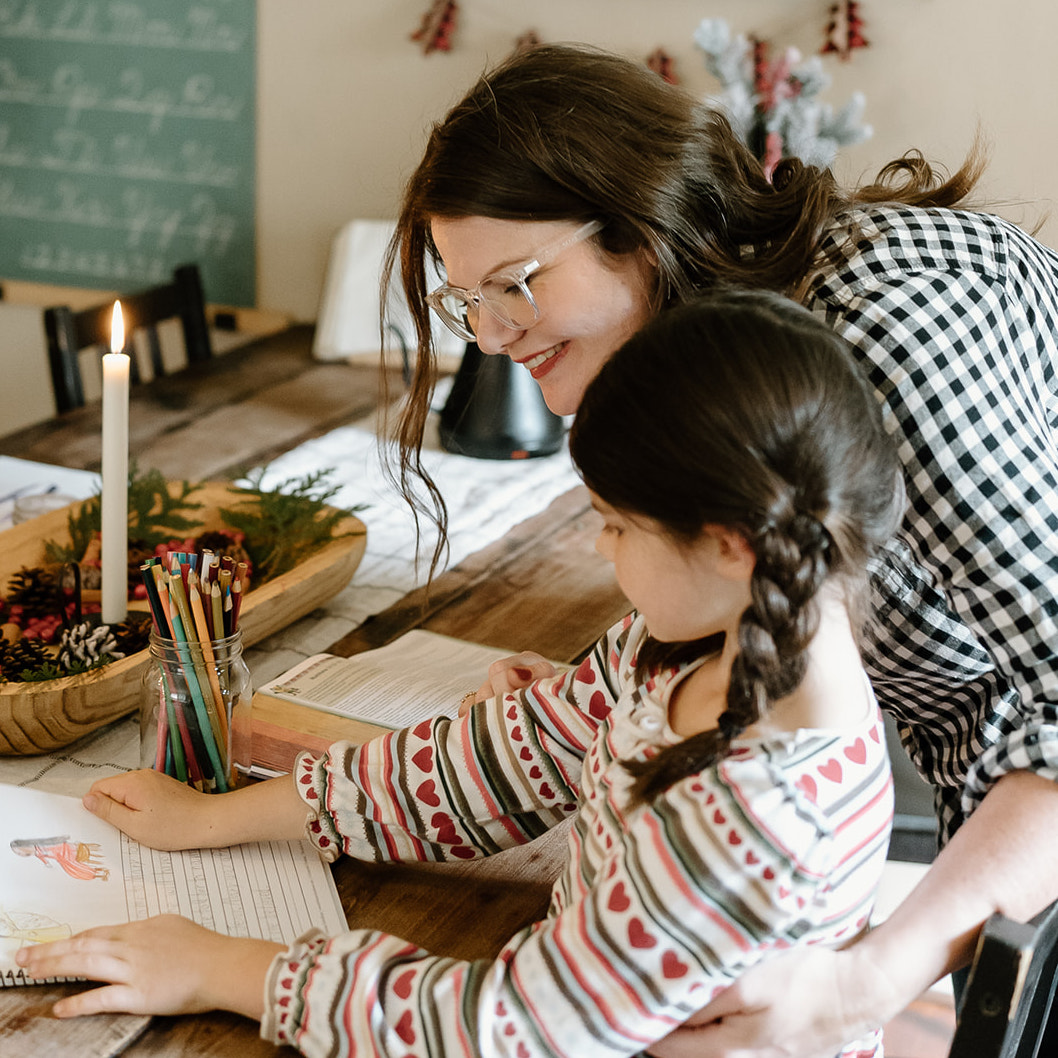One of my very favorite “funny things kids say” moments was when my daughter was 3 years old. It was Easter time and I had set out all of our materials to dye Easter eggs.
I mentioned the plan for the morning to my daughter: “We are going to dye Easter eggs today, honey!” She looked at me with the sweetest, puzzled face and said, “Why are we going to kill the Easter eggs? … Oh! Is it because Jesus ‘dyed’ on the cross?”
I realized she had never heard the term “dye” before. Plus, she had just recently come to understand what “die” even means, in reference to Jesus dying. It’s really a lot for their little minds, isn’t it?
As Easter approaches, your children may be asking you questions about Jesus. Maybe they are hearing things in church or having questions as they read through picture books that share the gospel. You may feel intimidated by the idea of clearly explaining the gospel to your children. Maybe you have this idea that they couldn’t possibly understand it fully, so why try? Or maybe you personally don’t understand it, so how could you possibly explain it to them? You might be wondering how to help your child understand things that are still a mystery to you. What a beautiful opportunity to journey together! I have learned so many of the most important things in life alongside my children. I encourage you to push through these awkward feelings and make this a priority in your home.
In this blog post:
- How to approach teaching the gospel to your children
- Sharing the gospel directly from Scripture
- Responding to the gospel
- Creating a gospel culture in your home
How to explain the gospel to your children

Teaching the gospel repeatedly, over time
Rather than viewing this as a one-time event, realize that teaching our children about Jesus is a journey, not a sprint. My first piece of advice is not to pressure or push. Your role as their parent is to share the truths of the gospel often and allow the Holy Spirit to open your child’s heart. If this Easter season is the first time you have opened the Bible with your child or have had these conversations, let me challenge you to make it a continual part of your life.
It is tempting to rush to the last point and seek what may be a premature response from a child by inviting them to respond by saying a prayer before they have an adequate understanding of what the gospel really is. I believe it serves children best in the long run when parents ensure their child clearly understands the full message of God’s redemption — including the story of creation, the fall, and God’s restoration through Jesus Christ — before jumping to the “punch line” of how to respond.
Elaborating on the gospel over time protects children from growing up trusting in an experience in which they prayed a prayer, without a real heart understanding and decision. It shifts their spiritual security from a one-time personal event to the actual substance of the gospel, which is centered on Christ’s sacrificial death and resurrection. For many people, salvation is not a one-moment revelation and decision, but instead, a process over many moments. Just continue to open the door and invite your child into a relationship with God.
Consider how you learned the gospel
As you consider how to teach your children the gospel, I think it is worthwhile to spend time thinking about your own experiences and how you understood the gospel when you learned it for the first time. I share my personal testimony in this blog post.
Here are some questions you may want to consider:
- If you were taught the Bible as a child, what was that experience like? Who shared the gospel with you? How was the gospel explained to you? What did you understand about the gospel as a child? During this time, do you feel like you grasped or understood the teachings shared with you?
- If you learned the Bible as an adult, is there anything you wish you had known or understood as a child?
- What Biblical teachings are important to you as an adult? Based on your experiences, what teachings are important to you to share with your children?
- Consider the individual personalities of your children. Are there ways you can communicate the gospel that will resonate with them individually?
- What do your children already know about the Bible and the gospel message based on what they have learned in your home and other settings?
- What do your daily rhythms communicate with your children about the gospel?
It may be helpful for you to spend some time thinking or journaling about your first experiences with Christianity, the Bible, and the gospel as you share it with your children. If you experienced confusion or negativity about any of this during a period of your life, I hope this time will bring healing and truth in your own journey as you evaluate how you can share the gospel in an authentic and meaningful way.
Teach the gospel as a story, not a formula
First off, tell your story. If you have made a personal decision to follow Christ, share your testimony with your children. Tell them what led you to that choice and what your relationship with Him is like. What changed in your heart and life since making that choice?
The gospel is the greatest story ever told. I am so thankful for excellent picture books that help share this story in an engaging way without straying from the truth. Here are some of my favorite books that explain the gospel in a child-friendly way. Having these resources in your homes and being available to discuss them with your children is a great first step.
- The Garden, the Curtain, and the Cross by Carl Laferton
- The Jesus Storybook Bible by Sally Lloyd-Jones
- The Biggest Story by Kevin DeYoung
- The Beginner’s Gospel Story Bible by Jared Kennedy
- The Gospel Story Bible by Marty Machowski
- Little Pilgrim’s Big Journey by Lithos Kids
Sharing the gospel directly from Scripture

Here are the key points of the gospel and some scripture to help guide you in understanding and explaining the gospel.
God created humans to be in a relationship with Him.
God made the whole world and everything in it. Because of this, God is also in charge of everything. He made people in His image and for a specific purpose. He created people for His pleasure — both to give Him glory and to have a relationship with us.
For in him all things were created: things in heaven and on earth, visible and invisible, whether thrones or powers or rulers or authorities; all things have been created through him and for him.
Colossians 1:16
Humans sin, and sin separates us from God.
Sin is choosing to disobey and dishonor God. The first two humans, Adam and Eve, sinned. They made a decision to be disobedient and ever since then, all humans (except Jesus) have sinned. This sin separates us from God. The separation created by sin was so big, and there was nothing humans could do to fix it. The only way to fix the problem was for a perfect, sinless one to take the punishment for all of humanity’s sins.
For all have sinned and fall short of the glory of God.
Romans 3:23
For the wages of sin is death, but the gift of God is eternal life in Christ Jesus our Lord.
Romans 6:23
God gave Jesus as a sacrifice to pay the price for our sins.
Jesus is God’s son. Jesus was born on earth — fully God and fully man. He lived a perfect and holy life, never once sinning. He was the only way to fix the problem. God made a choice to send his only son, Jesus, as the one who would take the punishment for everyone’s sins. Jesus suffered and died on the cross to pay the punishment that our sins deserve. Three days later, Jesus rose to life and defeated death. This showed God’s great power and that what God had been saying since the beginning of time was true! Jesus paid the price and now God sees us as blameless and we can live close with God again.
For God so loved the world that he gave his one and only Son, that whoever believes in him shall not perish but have eternal life. For God did not send his Son into the world to condemn the world, but to save the world through him.
John 3:16-17
God gives us the opportunity to accept the free gift of salvation and eternal life (becoming spiritually alive).
Salvation means “to be saved.” Because of what Jesus did on the cross, we have the chance to be saved from separation from God forever. We can’t be good enough to earn that salvation. It is a free gift from God. Eternal life means knowing God and coming alive spiritually.
For it is by grace you have been saved, through faith — and this is not from yourselves, it is the gift of God — not by works, so that no one can boast.
Ephesians 2:8-9
If you declare with your mouth, ‘Jesus is Lord,’ and believe in your heart that God raised him from the dead, you will be saved. For it is with your heart that you believe and are justified, and it is with your mouth that you profess your faith and are saved.
Romans 10:9-10
And this is eternal life, that they know you the only true God.
John 17:3
Responding to the gospel

The Bible instructs us on how to respond to the gospel. Once again, don’t force your child through these steps. Often, when a child or adult truly grasps the gospel they walk themselves through these steps without a list or a guide. I personally like having these key points as references in my own mind to remind myself as I walk a child or adult through responding to the gospel when they are ready.
- A. Admit & Ask: We admit that we are sinners in need of a Savior. We ask Jesus to forgive us for our sins and turn away from our sins.
- B. Believe: We believe that Jesus is God’s son and that what Jesus did paid the price for our sins.
- C. Confess & Commit: We confess our faith in Jesus Christ as Savior and Lord. We commit to a life of knowing and following him.
Creating a Gospel culture in your home

Discussing the Bible in your home, between parents and children, is special. Not only do children get to learn about the gospel from you, but this will inform so many aspects of your home life. Teaching the gospel in your home shows children the invaluable aspect of a personal relationship with God that is separate from other ways we experience Christianity in our churches and our community.
Some resources I have used over the years to develop a God-centered home are Habits of the Household by Justin Whitmel Earley and The Mission of Motherhood: Touching Your Child’s Heart for Eternity by Sally Clarkson.
The gospel is not just a holiday event. If you are looking for tools to continually open the Bible and allow the gospel to be a part of your family culture, I recommend attending a local church, praying as a family, and starting a family devotional with your children. Here are some family devotionals we have designed to study the Scriptures together with your family and children.
An Expectant Easter

I wrote An Expectant Easter to help parents bridge the gap between sharing the gospel and giving children ownership of their decision to follow Jesus. Your family will spend three weeks connecting together and focusing on the newness of spring, the sacrifice that Jesus made, and the power of His resurrection.
The foundation of your lesson time is reading a passage of scripture to your children. These passages are studied in chronological order to complete the crucifixion and resurrection story by the end of the curriculum. The gospel will be forever engrained into their minds and hearts. Children will orally narrate each Bible story and complete a written narration in their “Easter Story Narration Notebook.”
Rooted Family Bible Curriculum

Rooted Family Bible Curriculum was designed for families to cultivate deep roots in the rich soil of God’s Word. It is a home Bible study created to instill courage, confidence, and Biblical character in your children by rooting them in their heavenly identity, their devotion to God, and the wisdom of Scripture. This study is about giving children a solid root system in the Word of God before we launch them into the world.
Each week includes five lessons that center on one declaration statement related to the themes of Identity, Devotion, and Wisdom. Rooted incorporates beauty subjects with Bible study including daily Scripture readings, discussion and prayer prompts, hymns, poetry, and art study.
Rooted is an open-and-go guide that works for any family—homeschooling or not. Each day’s lesson could take anywhere from 15 minutes to an hour, depending on how deep your family gets into the discussion and your choice to include optional Connection Activities such as hymn study, science connections, copywork, journaling, and art projects.
Flourish Family Bible Curriculum

Flourish Family Bible Curriculum is an 18-week family Bible curriculum. Each week centers around one declaration statement related to the themes of Mission, Virtue, and Love. Flourish incorporates beauty subjects with Bible study including daily Scripture readings, discussion and prayer prompts, hymns, poetry, and art study. Enjoy the rhythms of connection and beauty found in our beloved Rooted Family Bible Curriculum with a focus on bearing fruit through our lives in the world around us.
Other books I have loved over the years are Our 24 Family Ways, The Ology and Leading Little Ones to God. We also love practicing Scripture memory throughout the year by incorporating it into our homeschool days with Light the Way Scripture Memory Sets.
Making the decision to follow Christ is the biggest, most amazing decision you or your child will ever make. It is my highest honor to answer any questions you have or walk alongside you as you or your child embark on the journey to follow Christ. Feel free to reach out to me anytime on Instagram or by email.
Have you shared the gospel with your children? What was your experience like? Share your story in the comments below.




